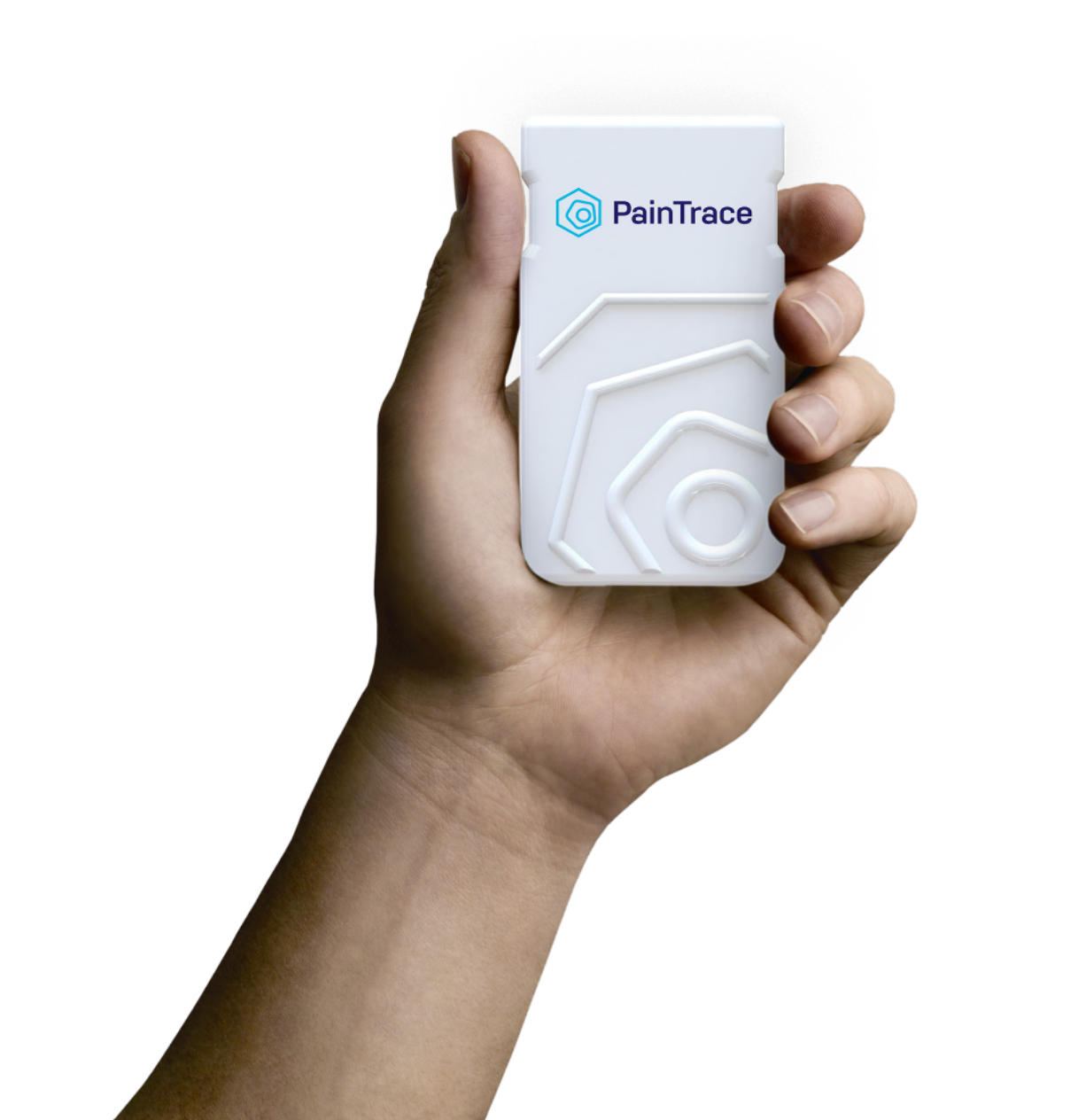Animal Health

Animal Health
PainTrace® is swiftly being adopted into veterinary care.

Veterinarians using the PainTrace® System have several common use cases:
- Detection and confirmation of subclinical pain; many veterinarians note PainTrace detected non-obvious pain and with follow-on advanced imaging revealed the etiology.
- Communication tool between colleagues and with pet owners; often veterinarians observe subtle painful behavior which may go unnoticed by others and PainTrace® is a valuable objective measure that creates shared understanding of the degree of pain.
- Pain Free Patients™; by introducing PainTrace® into wellness exams minor discomfort receives proactive treatment and procedures benefit from optimized pain management.
Spectrum of Care: from early times to the good old days
PainTrace Pain Free Pets™ is our mission
PainTrace® is an important component in our pledge for pain free pets.
- PainTrace® Wellness exams detect subclinical pain at early stages introducing proactive care
- Geriatric and Pain Management supported by PainTrace® can optimize protocols based on individual response to treatments
We Have A Shared Vision
We all strive to provide the best patient care possible
There are multiple focuses in veterinary care. Whether your focus is General Practice, Surgery, Rehabilitation, or other Specialties, read on to learn what peers say about PainTrace®.

General Practice
“We see many pet parents in our practice that live in a “yellow light” zone. This means they are not immediately saying no (red light) when it comes to diagnostics and treatment but they are also not easily saying yes (green light) either. PainTrace is an amazing “bridge” to providing the best care for pets when it comes to any condition that can be associated with pain. I find that when I offer PainTrace and perform this test with pet parents in the room, the compliance rate becomes much higher when together we can visualize the pain spikes. I am a firm believer that seeing is believing for so many things in life, and PainTrace is another testament to this. There is no question that having this technology has helped us demonstrate the value of what we do as a team and helps pets get the diagnostics and treatment that they deserve.”
– Dr. Boaz Man, DVM
“While at Washington State University our team performed TPLO's along with PainTrace and found it to be an effective pain measure. Reviewing PainTrace data we were able to remotely monitor dogs during overnight recovery, monitored pain, and even saw exactly when they began weight bearing after surgery. PainTrace is an important tool to improve patient care by measuring and monitoring both acute and chronic pain."
- Dr. Tammy Grubb, DVM, PhD, DACVAA

Surgery

Treatment
“PainTrace is a game changer that aids towards evaluating the location of pain, severity of pain, and treatment efficacy. PainTrace is an excellent device to assist with communicating patient pain to owners. In a fast-paced work environment, PainTrace helps me, as a busy clinician, to slow down and thoroughly evaluate every joint during my orthopedic exams to ensure I detect even the most subtle lameness.”
- Dr. Megan Kelley, DVM, CVA (IVAS), CVSMT, FCoAC
“The ability to assess pain levels for dental care is more challenging than flexing a joint or watching the patient’s gait. By using PainTrace, a pre-operative assessment can be compared to post operative readings to quantify the patient’s response to therapy. Utilizing PainTrace during the procedure, rather than relying on monitoring heart rate and blood pressure, we are able to recognize pain and can help provide better analgesia throughout the procedure, from starting a CRI to giving additional opioids or local/regional blocks”
- Dr. Heidi Lobprise, DVM, DAVDC

Dental

Behavior
“As a behaviorist, I can’t touch half my patients, so having a way for the owner to apply something to the pet to determine if it is actually painful, because behavior very much can stem from pain, especially aggression.”
- Dr. Amy Pike, DVM, DACVB, IAABC-CDBC
“I thought it was a failure when PainTrace detected neck pain but the dog showed no clinical sign of pain, and then the MRI confirmed a cervical spine tumor. PainTrace was right!”
- Dr. Mike Petty, DVM, CVPP, CVMA, CCRT, CAAPM

Oncology
General Practitioner
Wellness Exam
“We see many pet parents in our practice that live in a “yellow light” zone. This means they are not immediately saying no (red light) when it comes to diagnostics and treatment but they are also not easily saying yes (green light) either. PainTrace is an amazing “bridge” to providing the best care for pets when it comes to any condition that can be associated with pain. I find that when I offer PainTrace and perform this test with pet parents in the room, the compliance rate becomes much higher when together we can visualize the pain spikes. I am a firm believer that seeing is believing for so many things in life, and PainTrace is another testament to this. There is no question that having this technology has helped us demonstrate the value of what we do as a team and helps pets get the diagnostics and treatment that they deserve.”
– Dr. Boaz Man, DVM


Surgery
“While at Washington State University our team performed TPLO's along with PainTrace and found it to be an effective pain measure. Reviewing PainTrace data we were able to remotely monitor dogs during overnight recovery, monitored pain, and even saw exactly when they began weight bearing after surgery. PainTrace is an important tool to improve patient care by measuring and monitoring both acute and chronic pain."
- Dr. Tammy Grubb, DVM, PhD, DACVAA
Treatment
Rehabilitation
“PainTrace is a game changer that aids towards evaluating the location of pain, severity of pain, and treatment efficacy. PainTrace is an excellent device to assist with communicating patient pain to owners. In a fast-paced work environment, PainTrace helps me, as a busy clinician, to slow down and thoroughly evaluate every joint during my orthopedic exams to ensure I detect even the most subtle lameness.”
- Dr. Megan Kelley, DVM, CVA (IVAS), CVSMT, FCoAC


Dental
“The ability to assess pain levels for dental care is more challenging than flexing a joint or watching the patient’s gait. By using PainTrace, a pre-operative assessment can be compared to post operative readings to quantify the patient’s response to therapy. Utilizing PainTrace during the procedure, rather than relying on monitoring heart rate and blood pressure, we are able to recognize pain and can help provide better analgesia throughout the procedure, from starting a CRI to giving additional opioids or local/regional blocks”
- Dr. Heidi Lobprise, DVM, DAVDC
Behavior
“As a behaviorist, I can’t touch half my patients, so having a way for the owner to apply something to the pet to determine if it is actually painful, because behavior very much can stem from pain, especially aggression.”
- Dr. Amy Pike, DVM, DACVB, IAABC-CDBC


Oncology
“I thought it was a failure when PainTrace detected neck pain but the dog showed no clinical sign of pain, and then the MRI confirmed a cervical spine tumor. PainTrace was right!”
- Dr. Mike Petty, DVM, CVPP, CVMA, CCRT, CAAPM